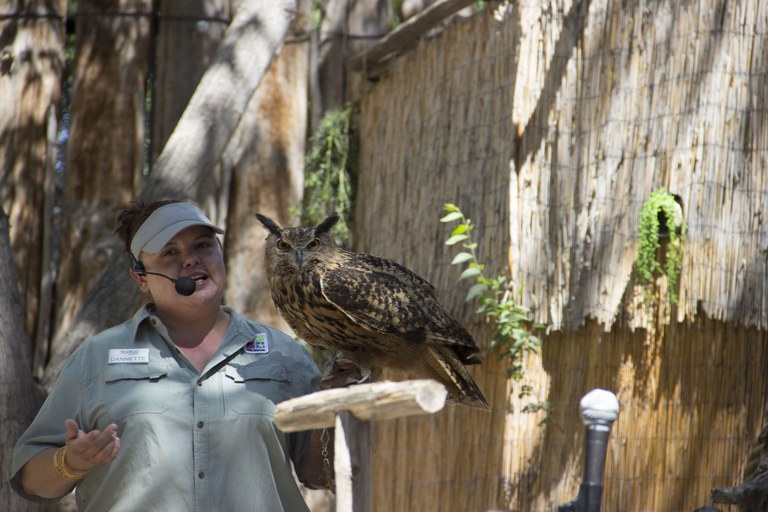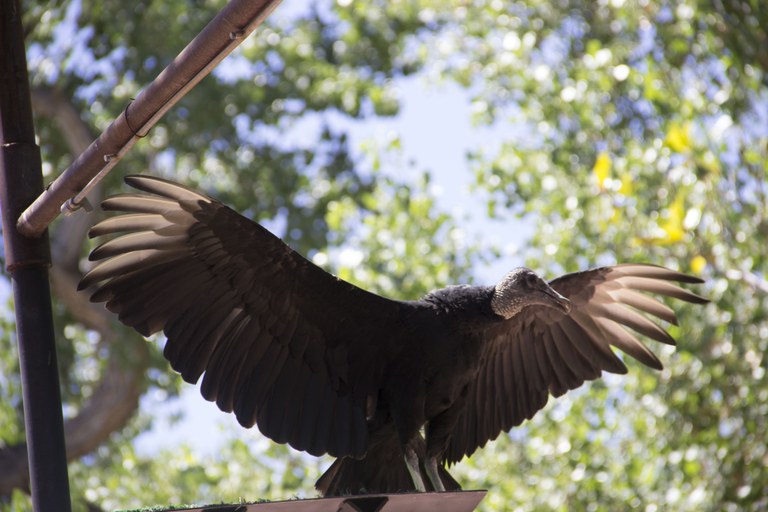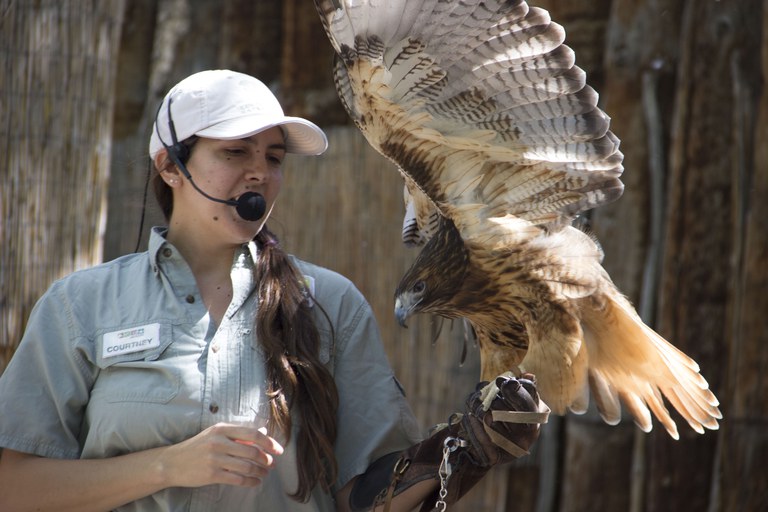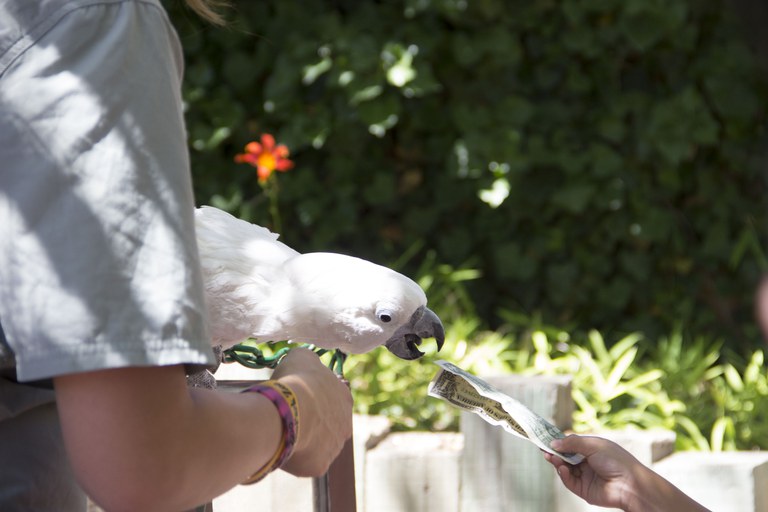Shining Stars
Rising stars and retirees
“He's a special bird,” says ABQ BioPark Senior Zookeeper Dannette Beck as she introduces us to Ernie the vulture.
With a body of black feathers (that appear brownish in the sunlight), a bald head and feet, and small brown, inquisitive eyes, it seems a parody that his kin are so poorly characterized in popular culture. Ernie looks more like a goof ball than a villain as he shuffles across his bedroom to get a better look at us.
As a chick, Ernie fell out of the nest. A well-meaning citizen who thought he was injured scooped him up and took him to a veterinarian. Since Ernie was raised by a person instead of a feathered mother, Ernie wasn’t suitable for release. Instead, he joined the cast of the Zoo’s Animal Encounters Show, which acquaints the public with a variety of species and lets the animals tout some of their natural behaviors.
Now far from his days as a rescue bird, he's adapted well to the show life. "He's got a great personality and likes to work with us," Beck says.
As Beck gives us a behind-the-scenes tour of the Animal Encounters stars’ sleeping quarters, she spouts off facts about each of them—she’s been working for the show for nearly 12 years, so you could say she’s pretty knowledgeable. “I love the animals, but I love talking about the animals too,” she says.
Cassidy is a red-tailed hawk. As we greet her, she vocalizes and attempts to figure us out. Beck says Cassidy “screams” each time she gets on stage—it’s just her thing. Despite her vocal nature, she’s very well behaved and easygoing, says Beck.
Like Ernie, Cassidy was a non-releasable bird. And she and Ernie aren’t the only ones—nearly every bird of prey on the show is a non-releasable rescue and nearly every parrot is an ex-pet. This includes the great horned owls, a Swainson’s hawk and Mallory the kestrel, who came in from Hawks Aloft with an injured wing.
Some of the animals are budding stars. Tytus the barn owl is not accustomed to the glove worn by keepers yet. This glove is necessary for a show though—trainers wear them to protect their hands when dealing with birds of prey, which have sharp talons.
“He’s so close to being on the show, but not yet,” says Beck.
Others are nearing the end of their stage careers—Seabert, a red-legged seriema, is backing off her routine now that she’s 28 years old. She decided she no longer wanted to “whack” a prop snake, which demonstrates a natural behavior for her species, so the crew is modifying her routine.
Retiree Falco is an American kestrel who is “getting up there in years,” according to Beck. “We’ll just retire him and he’ll spend the rest of his days back here enjoying his food.”
There are a number of reasons why one of the cast members might retire, but most of the time it’s because of age or health issues.
“We let the animal tell us because it’s all very different depending on the individual,” says Beck. “This should be fun for them—this shouldn’t be something they have to do.”
Showtime!
While the shows may look calm from the audience’s perspective, there is a lot of work going on behind the scenes.
“On the stage we look poised, but backstage we sometimes feel like chickens with our heads cut off,” says Beck. “It’s a very choreographed, highly detailed endeavor.”
There are a lot of considerations. Trainers need to get all of the animals in the right place. They need to make sure they don’t have predators crossing prey. And they even have to deal with the whims of the show's stars.
During a show this July, Ernie flew out to a platform and refused to return to Beck. Instead, he spread his wings and basked in the sunlight. The audience ate it up, and eventually Ernie decided to make his way back to Beck and the stage. Beck even made several jokes about the situation, to the audience's delight.
“Some days they’re just not into it, but the audience loves it when the animals don’t do what we've trained them to do,” says Beck.
Sometimes one of the birds becomes curious about its surroundings and explores other areas of the zoo.
“One thing you have to learn—it’s not a matter of if they’ll fly off, it’s when."
Birds generally fly back when they see or hear someone they know, but the crew keeps an “emergency mouse” to help make a return more enticing.
Still, it appears that the animals love show time. Some even get excited when they hear the pre-show music.
“When the music starts, they get all worked up back there for their treats,” says Beck.
In fact, food is used a lot in training. To get the animals interested in displaying desired behaviors, trainers use nuts, pellets, grapes and various meats.
Beck says it’s important to balance between keeping the animals motivated and over feeding them, though.
“Fat animals don’t perform either,” she says.
The Making of a Star
The Animal Encounters crew has a pretty busy day. In the morning, the trainers check all the animals and prepare diets. On some days, they might get ambassador animals to tour the zoo and meet folks—this may include Ernie, Homer the porcupine or Savannah the serval. Shows are at 11 a.m. and 2 p.m. and sometimes the crew can fit in a training session after the last show of the day.
“If we’re lucky we’ll get a lunch,” Beck laughs.
Although Beck says staff engages in “hardcore training” with the animals in the spring, she says that every interaction with an animal conditions them.
Sometimes training a new cast member means understanding when to retreat, Beck says. “We try never to force them to do anything they don’t want to do. It’s my job as a trainer to know that they’re not comfortable and that I need to back off.”
And sometimes trainers need to recognize the signs that an animal is just not fit for shows—avoidance behaviors and a lack of confidence are reasons for concern.
When they train a new animal, Beck says the key is to start small and work up to bigger behaviors. Trainers also have to slowly get animals acclimated to performing in front of audiences, so zoo staff helps out by attending some training sessions.
And it's all about those small steps. Beck recounts an experience with Independence, a bald eagle that was rescued on July 4, 2011, after being found floating down the Delaware River on the East Coast. Independence was injured and unhealthy, but luckily made it to a rehabilitation facility. She had injuries that prevented her from being released and so she came to the ABQ BioPark. Beck says it was special to her when Independence—a wild bird—decided to participate in her training for the first time. “The first time Indy stepped onto the glove I just melted.”
All their hard work pays off. Audiences respond positively to the shows’ stars. After each show, visitors stand in line to give Darby the cockatoo their dollar bills—she skillfully places them into a donation box (the New Mexico BioPark Society gives this money to conservation organizations). Kids also crowd around to meet the show’s alligators and Beck says the talking parrots and owls are also popular.
“Owls get people’s attention like no other,” she says. “Every group is a little different, but the owls tend to get an ‘ooh ahh.’”
The Animal Encounters show runs during the spring, summer and fall. Find information about show times here.
-Tina Deines

Photos (from top): Ernie the vulture displaying wingspan, Cassidy the red-tailed hawk spreading her wings, Darby the cockatoo taking cash for the donation box, Beck with Luna the Eurasian eagle owl.




